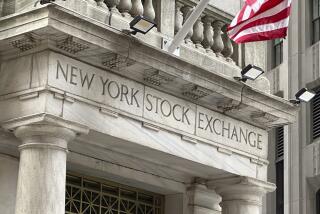3 retailers’ quarterly earnings reports are mixed but downbeat
Three major retailers reported quarterly earnings Thursday, with mixed results that underscored the continued problems plaguing the economy.
Discount giant Wal-Mart Stores Inc. said its second-quarter profit beat expectations but also reported that sales fell; trendy clothing company American Apparel Inc. said earnings plummeted 34% compared with a year earlier; and upscale department-store chain Nordstrom Inc. reported that its profit declined 27% but raised its full-year forecast.
“The earnings reports tell me that we’re not even close to seeing the end of this recession,” said Britt Beemer, chairman of America’s Research Group, a consumer behavior firm. “If Wal-Mart can’t break even for [comparable]-store sales, this economy is still in terrible shape.”
Consumers’ frugal spending continues to affect merchants in all sectors. The Commerce Department said Thursday that retail sales fell 0.1% in July, month-over-month; analysts had expected a 0.7% gain.
Although car sales, aided by the government’s “cash for clunkers” program, jumped 2.4%, there was widespread weakness. Gasoline stations, department stores, electronics sellers and furniture stores all reported declines.
Wal-Mart, which has grabbed market share from competitors during the recession because of its array of low-priced necessities, reported virtually flat second-quarter profit compared with last year.
The company said it made $3.44 billion, or 88 cents a share, for the three months ended July 31; it reported a profit of $3.45 billion, or 87 cents, a year earlier. Still, the earnings beat Wall Street expectations and were at the high end of the company’s forecast range.
“Customers around the world are forced to do more with less, and they rely on Wal-Mart to help them save money,” Chief Executive Mike Duke said in a statement.
“In a sales environment more difficult than we expected, we managed our operations in a disciplined manner,” he said.
But it wasn’t all good news for the world’s largest retailer, which reported that sales at its U.S. stores open at least a year -- known as comparable-store sales and considered to be an important measure of a retailer’s health -- slid 1.2% compared with a year earlier. Total net sales fell 1.4% year-over-year to $100.1 billion.
Despite the sales decline, “we believe that our comparable-store sales continued to outperform the retail sector almost everywhere we do business,” Duke said.
Industry watchers had eagerly awaited the company’s quarterly sales performance -- its first since it stopped reporting sales on a monthly basis after posting April results.
Wal-Mart has said it decided to stop reporting monthly sales to encourage Wall Street to take a longer-term view of the company. The move also has helped the discount giant avoid the volatility that can come with reporting sales on such a frequent basis. Analysts have worried that the absence of monthly data from the retail behemoth could make it more difficult to gauge how the industry is doing.
Wal-Mart, based in Bentonville, Ark., has been one of the few bright spots in the retail industry during the economic downturn. Walmart U.S. said it expected comparable-store sales during the third quarter ending Oct. 30 to be between flat and 2%.
At American Apparel, profit for the second quarter was $4.5 million, or 6 cents a share, down from $6.8 million, or 10 cents, a year earlier.
The Los Angeles clothing company, known for its colorful basics and racy ad campaigns, reported net sales of $136.1 million for the quarter that ended June 30, a 2.3% increase year-over-year. Comparable-store sales fell 10%.
“Our team has been active in rationalizing our cost structure and operating more efficiently, as well as reinvigorating and repositioning the brand in our key metropolitan markets,” CEO Dov Charney said in a statement. “We believe that our business is well positioned for the long-term and that the company will emerge from this consumer downturn with an enhanced ability to deliver on revenue and profitability targets.”
But American Apparel also said that “based on continuing challenging conditions,” it expected that its full-year earnings would range from a net loss of $1 million to a profit of $4 million.
Nordstrom’s second-quarter profit fell to $105 million, or 48 cents a share, from $143 million, or 65 cents, in the same period last year. The 27% decline matched analysts’ expectations for the retailer, which has struggled in recent months and slashed prices as consumers scrimp on luxury purchases.
The Seattle chain’s net sales fell 6.2%, to $2.14 billion, from $2.29 billion in the second quarter of last year. Sales in stores open at least a year fell 9.8%.
Still, Nordstrom said its performance for the quarter ended Aug. 1 was better than it expected and raised its full-year earnings forecast to a range of $1.50 to $1.65 a share, from a range of $1.25 to $1.50.
On Thursday, Wal-Mart shares rose $1.37, or 2.7%, to $51.88. American Apparel and Nordstrom reported their earnings after the markets closed; during regular trading, American Apparel shares rose 8 cents, or 2%, to $4 and Nordstrom shares rose 34 cents, or 1.2%, to $29.76.
Beemer of America’s Research Group said that based on consumer spending patterns, he didn’t expect a retail turnaround before Labor Day 2010.
“The consumer has got to come back in a pretty big way if the economy is going to recover,” he said.
--
More to Read
Inside the business of entertainment
The Wide Shot brings you news, analysis and insights on everything from streaming wars to production — and what it all means for the future.
You may occasionally receive promotional content from the Los Angeles Times.










